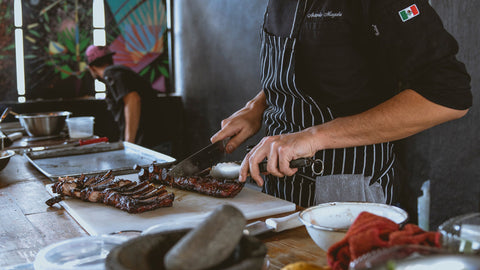It goes without saying that knives can cause a great deal of damage where accidents occur. Whether blunt or sharp, knives need to be respected - a sharp knife can slice easily through skin, while a blunt knife can slip during use therefore increasing the risk of injury.
The risk of injury can be minimized by being smarter and more careful in the kitchen. Here are several ways to reduce the risks:
- Sharpen your Knives regularly - As mentioned above, dull knives can slip during use and cause issues. Sharpening your knives regularly with a mechanism such as a sharpening stone will ensure that your knives remain at optimum performance.
- Pay attention to your non-cutting hand - Often overlooked, it is important to be aware of the position of your guiding hand. When slicing through food make sure to slice away from your hand as this avoids an accident if the knife slips.
- Stabilize the cutting board - It is not only the knife that can slip. The cutting board should also be stabilized and this can be achieved by placing a damp cloth under the cutting board.
- Protect your guiding fingers - It is better to nick your knuckle than slice through a fingertip. Curl your fingers so that the knife rests against your knuckles and hold the food that you are cutting with your fingertips when chopping and dicing.
- Let a falling knife fall - Don’t be a hero and try and snag the knife like a shortstop. Step back and let it drop to the surface, with the only action you should be taking is making sure that you scoot your feet backwards out of the way.
- Don’t keep cutting if distracted - In the home environment there can often be many distractions. In the case where you are interrupted from your chores, stop cutting and place the knife down flat on a secure surface, away from the reach of children.
- Take caution when handing over a knife to someone - When handing a knife to someone else to assist in the kitchen, place it down on a clean surface and allow them to pick it up for themselves.
- Carry a knife with care - If you need to move around the kitchen be careful to carry the knife down against your side with the blade angled away from your body. This means that if you drop it accidentally then it would not land in your foot.
- Use the correct knife for its chosen purpose - Different knives perform best under different situations. Make sure that you are using the correct knife for the correct task. For example, don’t use a paring knife when carving meat as this will likely increase the risk of something going wrong.
- Do not place knives close to the edge of a surface - When putting down your knife, always place it in the center of a flat surface and never towards the end. Placing it at the end will increase the risk of the knife falling if accidentally bumped.
- Store your knives effectively - Not only is it vital to keep your knives out of the reach of young children, it is also important to place them in a safe, secure and clean environment to protect them from damage. Often moisture can build up in drawers, or if the knives are left for too long in the dishwasher. Placing your knives on a magnetic knife stand, out of the reach of children, is highly recommended.
- Provide additional knife protection with a sheath - By placing your favorite knife in a leather or wooden knife sheath, you can add an extra layer of protection against damage and limit the risk of being cut when retrieving your knife for kitchen use.
- Never slice food items freehand without a cutting board - This one goes without saying but you always need to have a stable cutting environment that allows your non-cutting hand to be far away from the danger zone. Cutting freehand (such as over the sink) with the food cradle in your non-cutting hand is a recipe for disaster.
- Keep the tip of the knife on the board when Mincing and Dicing - Due to the delicate cuts that are produced when mincing and dicing, it is best to keep the tip of the blade on the cutting board and pump the handle up and down. This is because with such small cuts, and with people generally rushing through this task, leaving the knife tip against the board will minimize the risk of injury.
- Never submerge a knife in water - While it is never a smart idea to leave a knife soaking in water because the handle may be damaged, it is even more concerning due to the lack of visibility when a knife is submerged. This can lead to someone being cut when reaching into the water, especially if it is not the person who placed the knife into the water in the first place - as they may be unaware of its presence.
